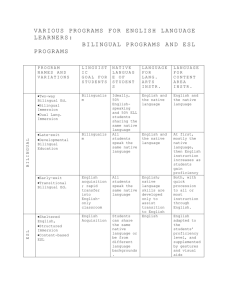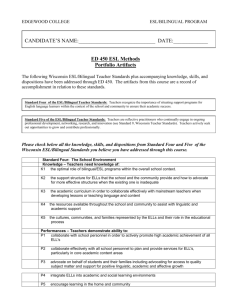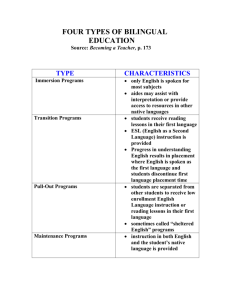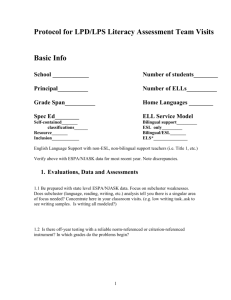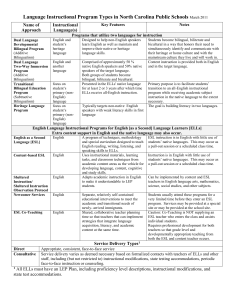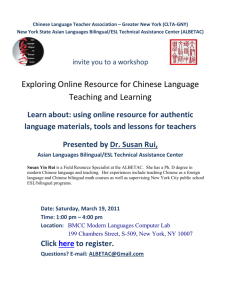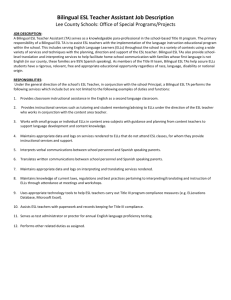Effective Pedagogy for ELLs - Dallas Area Network for Teaching and
advertisement
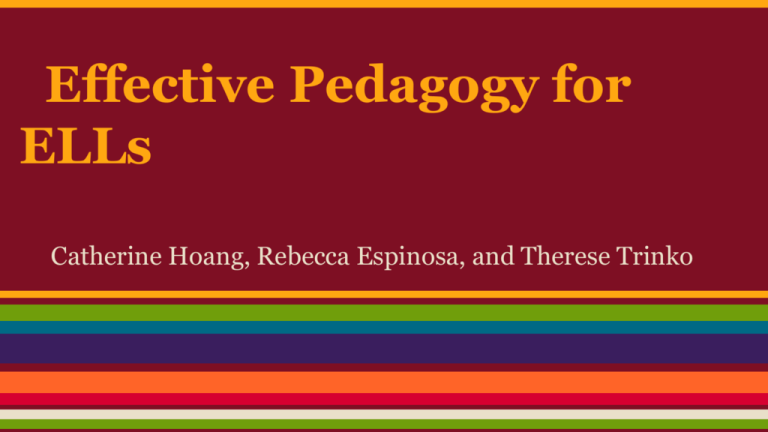
Effective Pedagogy for ELLs Catherine Hoang, Rebecca Espinosa, and Therese Trinko Poll Should immigrants coming to America assimilate or preserve their native culture? Text to: 37607 If you agree with... -Assimilate: Text 393584 -Preserve their native culture: Text 393585 Goals ❖ Participants will be able to name and explain the major types of programs for ELLs. ❖ Participants will be able to explain the benefits and challenges of each program. ❖ Participants will discuss the components of a successful language program. ❖ Participants will be able to recommend a program for a specific district. Legality and History ❖ Bilingual Education Act (1968) ➢ Civil Rights Title VI ➢ Requires schools to provide “equal educational opportunities” for language-minority students ❖ ELL students must be in a program until they can read, write, and understand English “meaningfully in all aspects of the school’s curriculum” ❖ The OCR does not require a specific program for ELL instruction. However, common programs include dual language, ESL, and immersion. http://www.facethefactsusa.org/facts/limited-english-students-test-public-schools Percentage of public school students who are ELLs by state. (20102011) Source: U.S. Department of Education, National Center for Education Statistics The Current State of ELLs in Texas ❖ ~800,000 students ➢ 15% total students National Center for Education Statistics, 2010-2011 ❖ ~10% ELLs in grades 7-12 were retained National Education Association, 2000-2001 ❖ ELLs dropout 4x more than native English speakers National Education Association, 2000-2001 Types of ELLs Newly arrived with adequate formal schooling ❖ Recent arrival: less than 5 years in the US ❖ Adequate schooling in native country ❖ May still score low on standardized tests Newly arrived with limited formal schooling ❖ Recent arrival: less than 5 years in the US ❖ Interrupted/limited schooling in native country ❖ Poor academic achievement Long-term English learning ❖ 7+ years in the US ❖ Have had ESL or bilingual instruction, but no consistent program ❖ Below grade level in reading and writing ❖ Discrepancy between student’s perception of achievement, and actual grades ❖ Some get adequate grades, but score low on tests Types of ESL and Bilingual models in Texas Bilingual Education Students are taught all subjects in their native language (such as Spanish, Mandarin, Navajo) and English Source: National Association for Bilingual Education English Immersion: ESL Classes ❖ At the elementary level, the students are pulled out from their regular classes for ESL instruction ❖ In middle and high school, the student is enrolled in an ESL course. (self-contained classroom) McKeon, ERIC Clearinghouse on Languages and Linguistics Reflective Question: What kinds of programs are most effective for promoting English language proficiency in US schools? Studies on Success Bilingual Pros (ESL) By high Pros school, dual-language students receive closer scores to English proficient students than ESL students Collier and Thomas, Educating English Learners “The more children develop their first language [...], the more successful they will be in academic achievement in English by the end of their school years” Collier and Thomas, Educating English Learners Teaching students in their first language promotes higher levels of reading achievements in English. Goldenberg, Claude, “Teaching English Language Learners” American Educator, 2008 English Immersion In Chicago area schools, English-immersion schools ELLs did better than bilingual schools ELLs Lexington Institute Structured English Immersion (SEI) is more effective than bilingual education. Horne v. Flores, op. cit. p. 24 California Prop. 227, which restricted bilingual education in public schools, benefited English learners. Rossell, Christine, “Dismantling Bilingual Education” Public Policy Institute of California, 2002 Summary Bilingual Pros: ❖ Better content knowledge ❖ Preservation of the native language ESL Pros: ❖ Faster English language speaking ability ❖ Tried and moderately true Krashen on Bilingual Education Ideal program would include: ❖ ESL instruction ❖ Sheltered subject matter teaching ❖ Instruction in the first language Source: Bilingual Education and Second Language Acquisition Theory by Stephen D. Krashen What’s “working” with Asian ELLs Alhambra School district in Southern California followed certain strategies to help their ELL students. These included: ❖ Early Intervention ❖ Multilingual Coordinators placed at various positions to bridge connections between parents and the school ❖ Regular Cultural and Diversity Training for staff, which led to an increase in student achievement (AYP scores for API students) ❖ Math: 63% in 2002 to 83% in 2008 ❖ English: 45% in 2002 to 69% in 2008 Source: National Education Association Discussion Questions ❖ What is the best way to teach ELL students? ➢ ESL content based ➢ ESL pull-out ➢ Transitional bilingual, early exit ➢ Transitional bilingual, late exit ➢ Dual immersion, one-way ➢ Dual immersion, two-way Effective Pedagogy for ELLs ❖ According to Tharp, “schools should teach students to be literate in the most general sense of the word capable of reading, writing, speaking, computing, reasoning, and manipulating visual as well as verbal symbols and concepts” (Rousing Minds to Life). ❖ What then is the duty of a school to provide for it’s ELL students? What should ELLs graduate knowing and which program best helps them achieve that? District Profile #1 San Francisco Unified School District, CA ❖ 26.5% ELLs ❖ 44 documented languages spoken in student body Source: District Data Center SFUSD SFUS D (2014) District Profile #2 Irving Independent School District, TX ❖ 39.3% ELLs ❖ 68.7% Hispanic/Latino Source: The Texas Tribune, Irving Independent School District District Profile #3 White County School District, GA ❖ 93.8% White ❖ 1% ELLs Source: Census Bureau “White County School District” 2009 What’s important Bilingual vs. ESL Immersion Education ❖ Should immigrants coming to America assimilate or preserve their native culture? ➢ Survey results ❖ What is more important for students to know, content or the English language? Final thoughts “We have already argued that teaching cannot be expected to occur unless schooling itself is organized in ways that support teaching.” (Rousing Minds to Life Tharp, 93) Bibliography Wetzel, Jennifer. "Educational Trajectories of English Language Learners Examined."Vanderbilt Research. Vanderbilt University, 15 Mar. 2012. Web. 08 Apr. 2014. "Local Education Agency School Universe Survey." Digest of Education. U.S. Department of Education, 2012. Web. 8 Apr. 2014. "Official Coca-Cola "Big Game" Commercial 2014 - America Is Beautiful." YouTube. YouTube, 02 Feb. 2014. Web. 07 Apr. 2014. McKeon, Denise. "Different Types of ESL Programs." ERIC Digest. Eric Clearinghouse System, 1987. Web. 08 Apr. 2014. "White County School District, GA (1305670) DP1 General Demographic Characteristics."Proximity One. Census Bureau, 2009. Web. 08 Apr. 2014. "Irving High School." The Texas Tribune. N.p., n.d. Web. 08 Apr. 2014. "District Data Center." SFUSD. SFUSD, 25 Sept. 2012. Web. 08 Apr. 2014. "Number and Percentage of Public School Students in Programs for ELLs." National Center for Education Statistics. Institution of Education Sciences, 2011. Web. 8 Apr. 2014 "English Language Learner/Bilingual." ECS Education Policy Issue Site. Education Commission of the States, n.d. Web. 07 Apr. 2014. Cox, Rachel, Sarah Glazer, Alan Greenblatt, Reed Karaim, Barbara Mantel, Patrick Marshall, Tom Price, and Jennifer Weeks. "Bilingual Education vs. English Immersion." CQ Researcher. Ed. Thomas J. Colin. SAGE, 11 Dec. 2009. Web. 8 Apr. 2014. Shoebottom, Paul. "More Advice about Teaching ESL Students (FAQ)." More Advice about Teaching ESL Students (FAQ). Frankfurt International School, n.d. Web. 08 Apr. 2014.

